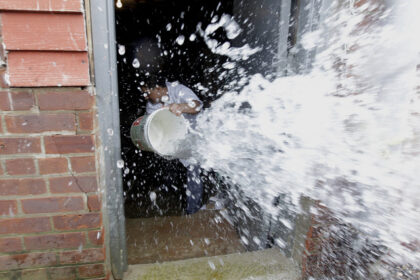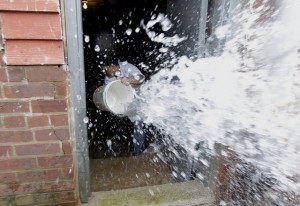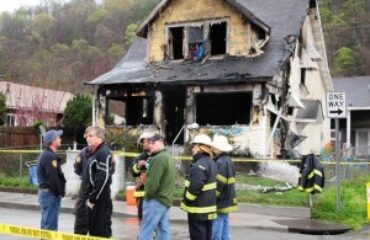
 New Jersey’s northern suburbs remained in Hurricane Irene’s grip, with swollen rivers keeping more than 10,000 people from their homes and utility crews working to restore power to 190,000 customers.
New Jersey’s northern suburbs remained in Hurricane Irene’s grip, with swollen rivers keeping more than 10,000 people from their homes and utility crews working to restore power to 190,000 customers.
The state, the most densely populated in the U.S., was awaiting word on Governor Chris Christie’s request for a federal disaster declaration. Janet Napolitano, U.S. secretary of Homeland Security, today was scheduled to tour the hardest-hit areas, within 50 miles (80 kilometers) of New York City. President Barack Obama will visit Paterson on Sept. 4, the White House announced today.
“We expect the flooding to start to end today,” Mary J. Goepfert, a spokeswoman for the New Jersey Office of Emergency Management, said in a telephone interview. “Today is going to be challenging, and part of tomorrow. I would not say that everything is going to be all and well by Friday.”
From the beaches of North Carolina to New York’s Catskill Mountains and the ski resorts of Vermont, Irene blew through the Eastern Seaboard last weekend, killing 45 people, causing losses of about $12.4 billion and leaving 6.69 million homes and businesses without power.
The U.S. National Weather Service posted flood warnings for the New Jersey counties of Morris, Essex, Passaic and Morris through this evening. No rain was forecast for the area.
New Jersey Shelters
Obama today approved disaster applications from North Carolina, where the hurricane made landfall Aug. 27, and New York, where it hit the following morning as a weakened tropical storm. Vermont, which sustained its worst flooding in 75 years, was declared a disaster area yesterday. The designation triggers cleanup and restoration funding from the U.S. Federal Emergency Management Agency.
In New Jersey today, 852 people were in shelters in seven counties, Goepfert said. The evacuees were among 10,107 residents still barred from their homes after 11 inland rivers and their tributaries crested, some at record levels.
Teams were preparing to survey damage near the coast and head north as floodwater recedes, Goepfert said. Municipal workers in beachside towns were repairing boardwalks and restoring dunes in preparation for the long Labor Day holiday weekend, which marks the end of the tourism season.
Fairfield Submerged
In Fairfield, a township of 9,000 about 25 miles northwest of New York City, some areas were 8 feet to 10 feet (3 meters) beneath water that had flowed from the Passaic River, Deputy Police Chief Anthony Manna said. He spoke during a tour with a reporter aboard a 2 1/2-ton military truck, which was submerged to the bumpers. National Guard troops and police officers in boats took some residents from their homes.
Bill Fitzgerald, president of the Fairfield Volunteer Fire Department, said the water measured a mile wide in some places, and carried raw sewage, gasoline and chemicals. Responders dodged barbecue tanks, lawn furniture and lumber, he said.
“The biggest danger we have going on?” Fitzgerald said during an interview at the firehouse. “Pick one: natural gas leaks, electrical lines down, people staying in their homes and water.”
In New York, 19 of 62 counties will be eligible for aid, according to a release from Governor Andrew Cuomo’s office today, one day after the governor asked Obama for help.
New York Damage
The damage in New York state will be almost $1 billion, with 600 homes wiped out, six towns inundated, 150 major highways damaged and 22 state bridges closed, Cuomo said. He estimated $45 million in agricultural losses on 140,000 acres, a figure that is rising, he said at a press conference in Prattsville, a Catskills town ravaged by torrential rains.
Of the 328,907 customers without power statewide, more than half were on Long Island, Cuomo’s office said. The Long Island Power Authority estimates that 95 percent of its 190,000 customers will have their power restored by Sept. 2 at midnight. In the Catskills, about 17,000 customers don’t have power.
“These are not communities of deep pockets, and these are communities that will need economic help to restore themselves,” Cuomo said at the news conference.
In Vermont, Route 4, a gateway to ski resorts, was severed in a dozen places, state officials said. In and around Killington, 10,000 residents and vacationers were stranded, Town Manager Kathleen Ramsey said yesterday.
In North Carolina, seven counties will be eligible for federal disaster funding. The hurricane destroyed more than 1,100 homes and caused damage of at least $71 million, Governor Bev Perdue said yesterday.
Damage South
“We are estimating right this minute that we’re up to about $70 million worth of damage, simply in things that we’ve eyeballed,” Perdue said yesterday at a news conference. “We know there will be significant add-ons to that number with the debris and the business interests, and obviously you will layer on that agricultural and other kinds of issues. This has become an expensive hurricane for North Carolina.”
Irene caused losses of about $12.4 billion in the U.S., according to an estimate by Kinetic Analysis Corp., a firm that predicts the effects of disasters. Insurers and reinsurers will probably cover about $4.9 billion of that cost, according to Kinetic.
“This was not a very strong wind event, but it was a very strong water event,” Jan Vermeiren, chief executive officer of Kinetic, said in a telephone interview. Private insurers “rarely offer flood insurance, they only cover damage from wind.


